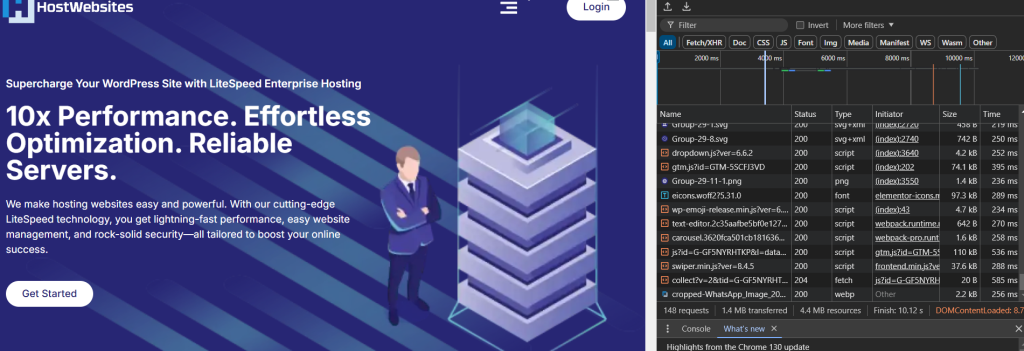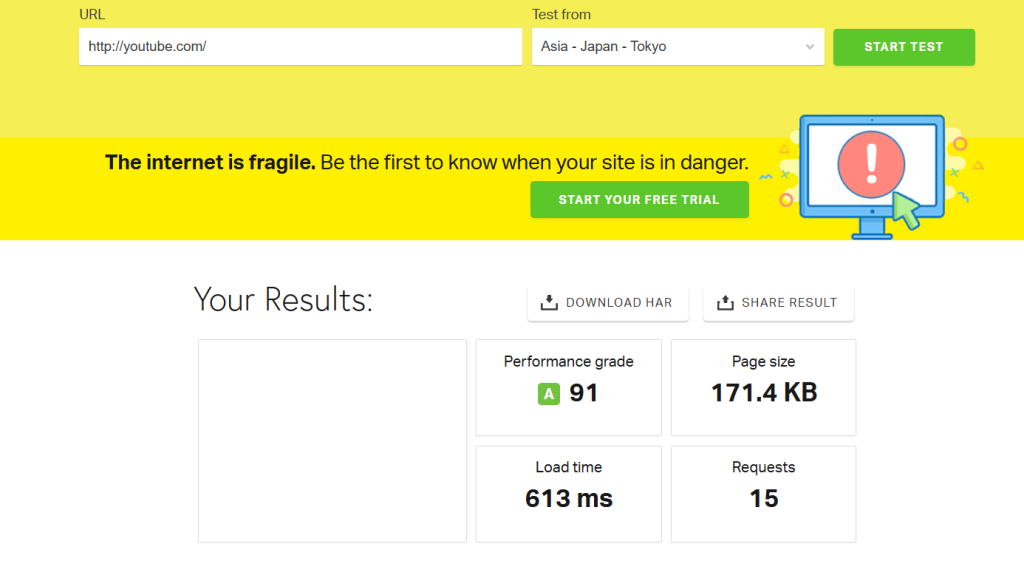Understanding website bandwidth is one of the most important factors to consider when developing a website in order to guarantee a seamless and fulfilling user experience. To put it simply, bandwidth is the most data that can be carried between a website’s server and users in a given length of time. Having adequate bandwidth is crucial for handling the traffic on your website since inadequate bandwidth can result in sluggish loading times, interruptions, and even crashes, all of which can impair user experience and website performance.
Analysing your bandwidth requirements is crucial for achieving the best possible performance, whether you’re building a high-traffic commercial page, an e-commerce site, or a personal blog. In order to give your visitors a flawless experience, this post will define website bandwidth, show you how much you need, and show you how to optimise its use.
What Is the Bandwidth of a Website?
The maximum speed at which information may move from the server that hosts your website to the users who are accessing it is known as website bandwidth. Gigabytes (GB) or terabytes (TB) per month are the typical units of measurement.
Consider Bandwidth Like a Highway
the more automobiles (or data) it can handle at once, the broader the highway. In a similar vein, a website with more bandwidth can accommodate more users by facilitating faster data transfers.
When the bandwidth limit of your website is surpassed, one of two things typically occurs:
Throttling or Slowing Down
Users attempting to access your website may noticeably experience a slowdown if your hosting company slows down the data transfer rate.
How Much Bandwidth Do You Need for Your Website?
The page weight of your website, the typical number of page views per day, and any downloadable content you offer are all important considerations when estimating how much website bandwidth your website requires. Below is a summary of each component and how it affects your total bandwidth needs.
- Calculate Your Page Weight: The total quantity of data sent each time a visitor loads a page is known as the page weight. HTML, CSS, JavaScript, pictures, and other multimedia components are all included in this data. Depending on your site’s intricacy and media content, page weight can vary significantly. While a media-rich page with videos and high-resolution graphics may quickly reach several megabytes (MB), a simple text-based page might just be a few hundred KB in size.
- Determine Average Pageviews per Day: The average number of times users visit your pages each day is the number of pageviews per day. To manage this load, more bandwidth will be required as your site receives more pageviews.
- Take into Account Downloadable Content: Your bandwidth usage will increase if your website permits people to download files (such as software, videos, or PDFs). The average file size and download frequency must be taken into account because every download uses bandwidth.
Estimating Page Weight
You can use your browser’s Developer Tools to determine the page weight:
Toggle “Disable cache” by selecting the Network tab in Chrome after opening Developer Tools (use OPTION + CMD + I on Mac or CTRL + SHIFT + I on Windows). You may determine the page weight by loading the page and seeing the total amount of data sent.
Here are two example of page weight.

In the above example, a complex page like Hostwebsites.io has a bandwidth of 1.4 MB.
Tools like Pingdom provide a simple way to check page weight and loading speed if you don’t want to make this calculation by yourself.

By determining these variables, you may determine the website bandwidth requirements for your website using a simple formula:
Bandwidth Requirement = [(avg. daily pageviews x page weight) + (avg. downloads per day x avg. file size)] x 30 x 1.5
Using a redundancy factor of 1.5 to account for unforeseen traffic spikes, this method lets you predict your bandwidth requirements for a month.
Here’s the page size of YouTube via Pingdom.

What Makes Bandwidth Vital?
Website performance is directly correlated with website bandwidth. For the following main reasons, having enough bandwidth is essential:
- Smooth customer Experience: Having enough bandwidth guarantees that visitors can reach your website quickly, which improves customer satisfaction. Long loading delays caused by insufficient bandwidth might turn off visitors and decrease engagement.
- Preventing Downtime: Websites with limited bandwidth may encounter outages if the limit is exceeded during times of high traffic, such as sales events, promotions, or peak hours. Maintaining uptime even during these increases might be facilitated by having enough bandwidth.
- Supporting Media-Rich material: Because these kinds of material take more data to load, bandwidth usage will be higher if your website has a lot of pictures, videos, or downloadable information.
Types of Bandwidth Plans
When choosing a hosting plan, you’ll typically encounter two types of website bandwidth plans:
Metered Bandwidth
The monthly website bandwidth allotment for these plans is limited. There may be more charges or throttling once you reach the limit. It is typical for lower-tier hosting plans to have accessed bandwidth.
Unmetered Bandwidth
You have more options with this kind because there is no upper limit. Unlimited website bandwidth is frequently included in dedicated or higher-tier hosting packages. However, “unmetered” does not always mean unlimited because there is usually an authorised usage restriction.
How to Increase the Bandwidth Efficiency of Your Website
You may save expenses and enhance website performance by optimising your site to use bandwidth effectively. Here are a few strategies to maximise bandwidth utilisation:
- Make Images Better – The heaviest components on a page are frequently images. Reduce file size without compromising quality by using effective formats like WebP and compressing images. You can automatically compress photos with tools like TinyPNG, ImageOptim, or the optimisation features built into platforms like WordPress.
- Put Browser Caching into Practice – By saving specific resources locally on their device, caching enables repeat users to load your website more rapidly. As a result, less data is sent from your server each time a user returns to the website.
- Allow Images and Videos to Load Lazy – Images and videos are not loaded until they are in the user’s line of sight thanks to lazy loading. Because only the media the user is actively viewing will require bandwidth, this avoids needless data transfer.
- Reduce Code and Turn on Compression – Reducing the amount of HTML, CSS, and JavaScript files makes your pages load more quickly and use less bandwidth. To automatically compress these files, you can also enable tools like Gzip compression on your server.
- Make use of CDNs (content delivery networks) – Cache versions of your website are kept on several servers across the globe by CDNs. Data is sent from the server nearest to the user when they visit your website, which lessens server load and maximises bandwidth.
- Consistently Check Bandwidth Usage – You can spot traffic spikes and make necessary adjustments to your plan by monitoring the bandwidth utilisation of your website. The majority of hosting companies give real-time bandwidth monitoring tools.
Choosing a Bandwidth-Related Hosting Plan
Depending on the particular needs of your website, selecting a hosting package with sufficient bandwidth is crucial to guaranteeing seamless operation. Here’s how bandwidth is usually handled by various hosting plans:
Shared Hosting: These packages frequently have bandwidth restrictions. For websites with little traffic, like personal blogs or small business pages, shared hosting could be appropriate.
Virtual Private Server (VPS) hosting: is perfect for expanding companies that anticipate moderate demand because it offers more bandwidth and resources than shared hosting.
Dedicated Hosting: High or unmetered bandwidth is typically provided by dedicated services. High-traffic websites that need reliable speed and performance can use this.
Cloud Hosting: With cloud hosting, you can often scale your bandwidth up or down based on your website’s needs, which can be a cost-effective solution for sites with fluctuating traffic.
Typical Myths Regarding Website Bandwidth
- Bandwidth and Data Transfer Are the Same
Although they are connected, bandwidth and data transfer are not the same thing. While data transmission refers to the actual volume of data transported within a specific time frame, bandwidth is the maximum amount of data that may be transferred over time. - Higher Bandwidth Result in Higher Speed
Higher bandwidth does not automatically result in faster websites, but it can accommodate more users without causing performance issues. Load times are greatly influenced by variables such as server hardware, page optimisation, and connection speed.
Conclusion
A seamless user experience and the avoidance of unforeseen costs depend on your ability to estimate your bandwidth requirements. When choosing a hosting plan, you may make an informed decision by figuring out your average monthly data transfer needs and optimising your website for effective bandwidth utilisation.
The traffic volume, content type, and user engagement of your website ultimately determine how much bandwidth is needed. You can make sure you always have the resources to provide your visitors with an excellent experience by routinely revaluating your bandwidth requirements as your website expands.
FAQs
Why is bandwidth on websites important?
Bandwidth is important since it impacts your site’s speed, performance, and the maximum number of users it can accommodate at once. Slow load speeds or failures during traffic surges might result from insufficient bandwidth, which can negatively impact user experience and could lower your website’s search engine rating.
What happens if I exceed my website’s bandwidth limit?
If you exceed your bandwidth limit, several things could happen depending on your hosting provider. Some may automatically charge overage fees, while others could throttle your site’s performance or temporarily shut it down until the next billing cycle.
What are the consequences of low bandwidth on my website?
Low bandwidth can lead to slower load times, poor user experience, and potential crashes during high traffic periods. These issues can reduce visitor engagement, lower conversion rates, and negatively impact search engine rankings.

